Eruption
andErosion
SciencetellsusadifferentstoryoftheIguazúFalls.Thefallsstartedtoformabout130millionyearsagowhenthesupercontinentGondwanabrokeapart.SouthAmericaseparatedfromAfrica.ThistriggeredoneofthelargestvolcaniceventsinEarth’s history.
Atthetime,theareawheretheIguazúFallsislocatedwasagiantdesert.LavapouredfromvolcanoesandotheropeningsinEarth’scrust.Itcoveredthedesert.Thenthelavacooledandhardened.Itbuiltupaplateaumadeofthree,massiveflatlayersofbasalt rock.
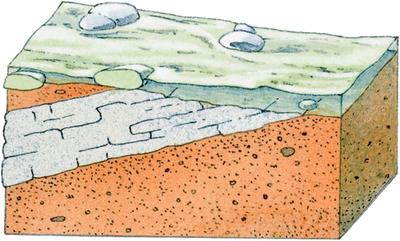
Waterfallsareformedasariverflowsfromhardrocktosoft rock.

Therivererodesthesoftrockatafasterrate.Itformsastepinthe river bed.
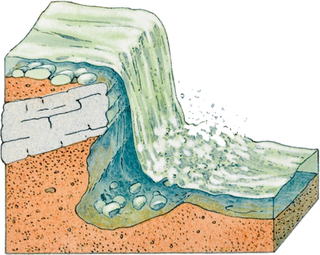
Thehardrockthatisleftcreatesahardledge.Theriverfallsoverthe ledge.
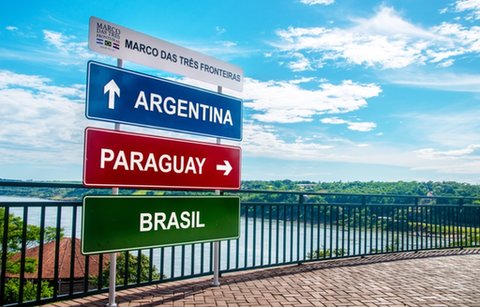
TheIguazúRiveremptiesintotheParanáRiverwherethebordersofBrazil,Argentina,andParaguaymeet.ThisareaisknownastheTriple Frontier.
ButEarth’splateskeptmoving.Thelayerswereliftedintoahighplateau.Faults,orcracks,appearedinthem.Waterstartedtorundownthefaultsanderoded,orworeaway,theland.ThemightyParanáriverbedformed.Muchlater,theIguazúRiverappearedandstartedtofeedinto it.
Thefallsstartedtoformatthesitewherethesetworiversmeet.Buttoday,theyareabout23kilometers(14miles)upstream.Erosion,onceagain,getsthecredit.AswaterfellintotheParanáRiverfromtheIguazú’splateau,it weatheredawaythelayersofrockonthebottom.Theupperlayershadnothingtosupportthem,so
they crumbled.
Today,thelayersofIguazúFallslooklikeagiantstaircase.Andalong,narrowcanyonwithscoresofrockyislandsleadsthewaytotheParanáRiver.Erosioncontinues,andthecanyongetsabout3millimeters
(0.1inches)longereach year.
Brazil
Argentina
Paraná
Iguazú
Paraguay
IntotheRainforest
Asamazingasthewaterfallsare,thewaterisjustpartofthebeautythatsurroundsIguazúFalls.TheyexistinthesubtropicalAtlanticForest,oneofthemostbiodiverseecosystemsinSouthAmerica.Itishometomorethan2,000plantspecies,
68mammals,422birds,morethan
40reptiles,18amphibians,and250typesofbutterflies.Manyoftheplantsandanimalsthatliveherearen’tfoundanywhereelseinthe world.
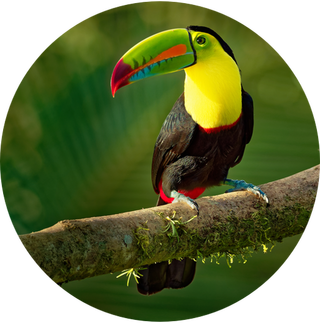
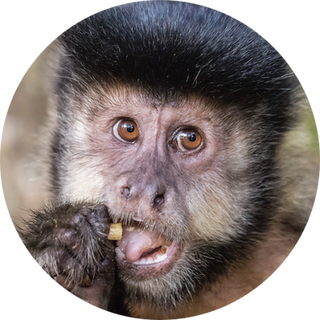
blackcapuchin monkey
toucan

Bewareofthecoatis!Theycaneasilybiteyourhandwhentheytrytograbyour food.
AsIwalkedthroughtherainforest,Isawtallpalmtreesandeventallerlaurelsandrosewoods.Papayafruithungfromsmalltreesundertheumbrellasofhuge leaves.
Flashesofblueflutteredthroughtheair.Youreyehadtobequicktospotthesebluemorphobutterflies.Ialsocaughtaglimpseofatoucaninflight.Isawcapybarassunningthemselvesontheriverbank.Ialsogotagoodviewofayoungcaimanrestinginshallowwater.Raccoon-likecoatisseemedtobeeverywhere!Ikeptaneyeoutfortapirs,monkeys,giantanteaters,orjaguars.Thoseanimalslivehere, too.